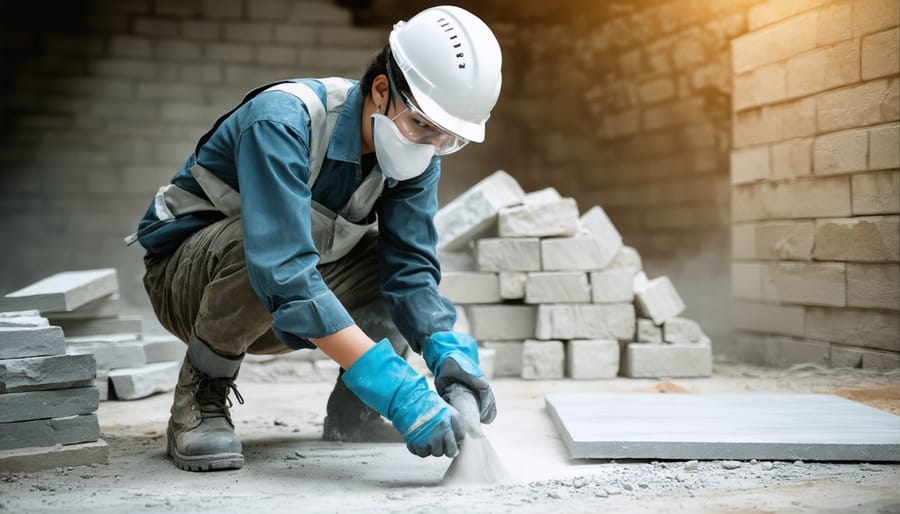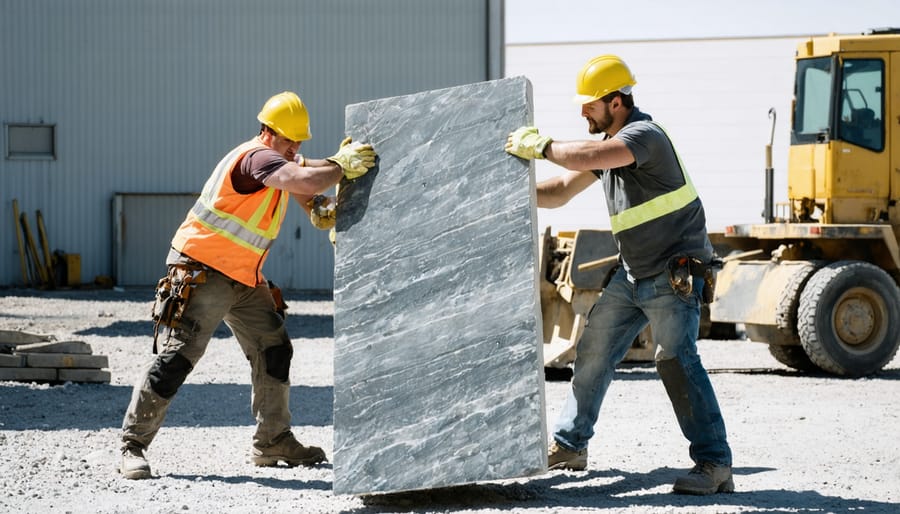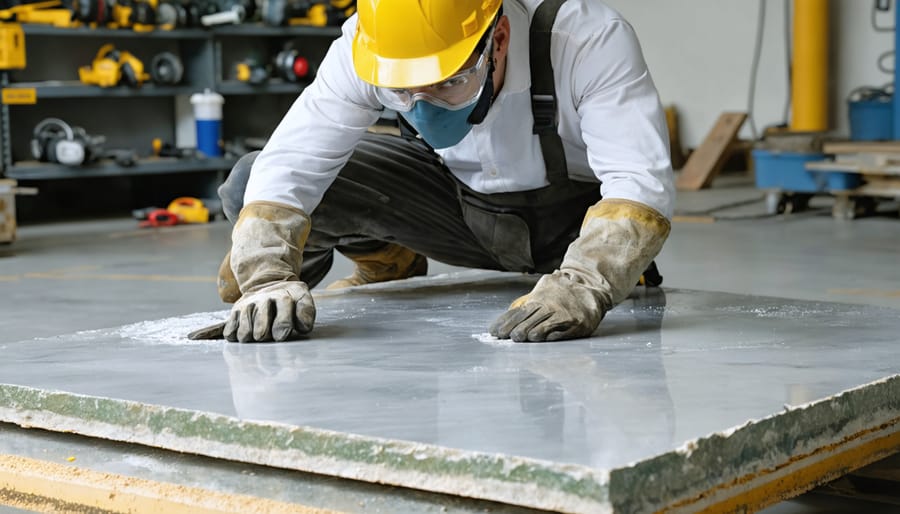Maintain the highest safety standards in your stone care routine by implementing a comprehensive maintenance protocol that protects both personnel and surfaces. Regular safety audits, proper equipment inspection, and documented maintenance procedures form the cornerstone of risk prevention in natural stone preservation. Professional stone maintenance demands strict adherence to OSHA guidelines, proper personal protective equipment (PPE), and thorough knowledge of chemical safety data sheets.
Safety in stone maintenance extends beyond immediate physical hazards. Proper ventilation during sealing operations, correct dilution ratios for cleaning solutions, and appropriate handling techniques prevent long-term health risks while ensuring stone longevity. Smart maintenance planning integrates safety protocols with preservation goals, creating a systematic approach that protects workers while maintaining stone quality.
Industry leaders recognize that effective maintenance programs balance thorough care with stringent safety measures. From selecting non-slip treatments for floor surfaces to implementing proper lifting techniques for stone transport, every aspect of maintenance must prioritize safety without compromising cleaning efficiency. This proactive approach reduces workplace incidents, extends stone life, and ensures compliance with industry regulations while maintaining the natural beauty of stone installations.
Essential Safety Equipment and Protective Gear
Personal Protective Equipment (PPE)
When working with natural stone, proper personal protective equipment (PPE) is essential for ensuring safety and preventing injuries. Start with safety glasses or goggles to protect your eyes from dust, chips, and chemical splashes. These should be impact-resistant and provide side protection for complete coverage.
Wear chemical-resistant gloves when handling cleaning solutions or sealants. Nitrile or neoprene gloves are recommended as they offer excellent protection while maintaining dexterity. For heavy-duty tasks like stone cutting or grinding, use cut-resistant work gloves.
Respiratory protection is crucial when working with dust-generating activities. Use a properly fitted N95 mask for basic dust protection, or a respirator with appropriate cartridges when working with chemicals or performing intensive cutting operations.
Protect your feet with steel-toed safety boots that offer slip resistance and protection from falling stone pieces. The boots should also be water-resistant to guard against chemical exposure.
For noise-intensive operations, use ear protection such as earplugs or earmuffs. Complete your PPE with appropriate work clothing, including long sleeves and pants made from durable materials that protect against scrapes and chemical contact.

Workspace Safety Equipment
A well-equipped workspace requires essential safety gear to protect against common hazards when working with natural stone. Safety goggles or face shields are mandatory to guard against dust and debris during cutting or grinding operations. Proper respiratory protection, including N95 masks or powered air-purifying respirators (PAPRs), prevents inhalation of harmful silica dust.
Heavy-duty work gloves protect hands from sharp edges and chemical exposure, while steel-toed boots safeguard against falling stone pieces. Ear protection is crucial when operating loud machinery like saws or grinders. Keep first aid kits readily accessible and ensure they’re fully stocked with wound care supplies and eye wash solutions.
For wet operations, non-slip rubber boots and waterproof aprons are essential. When handling large stone pieces, back support belts help prevent injury. Always maintain proper lighting in work areas and keep safety equipment organized and easily accessible. Remember to regularly inspect and replace worn safety gear to ensure optimal protection. A clean, organized workspace with properly maintained safety equipment significantly reduces accident risks and promotes a safer working environment.
Safe Handling and Cleaning Protocols
Proper Lifting Techniques
Proper stone handling requires strict adherence to safe lifting techniques to prevent injury and protect valuable materials. Always assess the weight and size of the stone before attempting to lift it. For items weighing more than 50 pounds, use mechanical aids like dollies, forklifts, or lifting straps, or work with a partner.
When lifting manually, maintain a stable stance with feet shoulder-width apart. Bend at the knees, not the waist, keeping your back straight and core muscles engaged. Get as close to the stone as possible before lifting, and avoid twisting movements while carrying the load. Instead, pivot your feet to change direction.
For larger slabs, utilize proper lifting equipment and ensure all workers are trained in its operation. Always wear appropriate personal protective equipment, including steel-toed boots, heavy-duty gloves, and back support when necessary. Take frequent breaks during extended periods of material handling, and never attempt to catch falling stone materials.
Remember that even small pieces can be deceptively heavy. When in doubt about your ability to safely handle a stone piece, always err on the side of caution and seek assistance.

Chemical Safety Measures
When working with chemical cleaning products on natural stone surfaces, proper safety measures are essential to protect both yourself and the stone. Always wear appropriate personal protective equipment (PPE), including chemical-resistant gloves, safety goggles, and respiratory protection when handling strong cleaning agents. Ensure adequate ventilation in the work area by opening windows or using fans to disperse fumes.
Before using any chemical product, carefully read and follow the manufacturer’s safety instructions and dilution ratios. Consider cleaning without harsh chemicals whenever possible to minimize risks. Store cleaning products in their original containers, away from heat sources and direct sunlight, and keep them out of reach of children and pets.
Never mix different cleaning products, as this can create dangerous chemical reactions. Have a spill containment plan ready, including access to absorbent materials and proper disposal methods. Keep a first aid kit nearby and know the location of the nearest eyewash station or emergency shower. In case of chemical exposure, follow the safety data sheet (SDS) instructions for immediate response and seek medical attention if necessary.
Equipment Operation Safety
Operating maintenance equipment safely is crucial when working with natural stone surfaces. Always wear appropriate personal protective equipment (PPE), including safety glasses, dust masks, non-slip footwear, and hearing protection when using power tools. Before starting any maintenance task, inspect all equipment for damage or wear, ensuring power cords are intact and tools are properly maintained.
When using wet equipment like polishers or grinders, ensure proper electrical safety by using GFCI-protected outlets and keeping water away from electrical connections. Position equipment cables and water hoses to prevent tripping hazards, and maintain a clear working area free from obstacles.
Never operate unfamiliar equipment without proper training or reading the manufacturer’s instructions. Keep guards and safety features in place, and never disable safety mechanisms. When using chemical cleaning agents, ensure proper ventilation and follow mixing instructions carefully.
Store equipment properly after use, clean and dry all components, and report any equipment issues immediately to prevent accidents. For powered equipment, always disconnect from power sources before making adjustments or changing attachments.
Risk Assessment and Prevention
Common Hazards and Solutions
Natural stone maintenance involves several potential hazards that require careful attention and proper safety protocols. Slipping on wet surfaces remains one of the most common risks, particularly during cleaning or in areas with high moisture exposure. To prevent slip-and-fall accidents, always use appropriate non-slip footwear and ensure proper drainage systems are in place.
Chemical exposure presents another significant hazard. Many cleaning products contain harsh substances that can cause skin irritation or respiratory issues. Always wear protective equipment, including chemical-resistant gloves, safety goggles, and respiratory protection when handling cleaning solutions. Proper ventilation is crucial when working with these materials indoors.
Physical injuries can occur from lifting heavy stone materials or using maintenance equipment incorrectly. Following proper lifting techniques and using mechanical aids when necessary can prevent strain and injury. Regular implementation of preventive maintenance strategies helps minimize the need for heavy-duty cleaning and repairs.
Cross-contamination between different stone surfaces can lead to damage and safety issues. Always use separate cleaning tools for different areas and follow manufacturer-recommended cleaning protocols. Store cleaning supplies properly in well-ventilated areas away from heat sources and direct sunlight. Maintain clear labeling on all chemical containers and keep safety data sheets readily accessible for quick reference in emergencies.
Emergency Response Procedures
In the event of an accident or emergency involving natural stone maintenance, quick and appropriate response is crucial. Always keep a well-stocked first aid kit readily accessible in the work area and ensure all team members know its location. For chemical spills, immediately contain the area using appropriate spill kits and follow the specific safety data sheet (SDS) instructions for the involved substance.
If someone sustains an injury, assess the situation quickly and call emergency services if necessary. For minor cuts or abrasions, clean the wound and apply appropriate first aid. In case of chemical exposure to skin or eyes, flush the affected area with clean water for at least 15 minutes and seek medical attention.
For equipment-related accidents, shut down all power sources immediately and secure the area to prevent further incidents. Document all accidents and near-misses in detail, including photographs when possible, to help prevent future occurrences and comply with safety regulations.
Establish and maintain clear evacuation routes and ensure all workers know the emergency assembly points. Post emergency contact numbers, including poison control, local emergency services, and relevant supervisors, in visible locations throughout the work area.
Regular emergency response drills and updated training sessions help ensure all team members can react appropriately during actual emergencies. Remember, personal safety always takes precedence over property or equipment protection.
Environmental Considerations
Ventilation Requirements
Proper ventilation is crucial when performing maintenance work on natural stone, especially when using cleaning chemicals or sealants. Always ensure adequate airflow by opening windows and doors when working indoors. For enclosed spaces, use portable fans to create cross-ventilation and remove potentially harmful fumes. If mechanical ventilation is available, activate it before beginning any maintenance work and leave it running throughout the process.
When working with strong cleaning agents or sealants, wear appropriate respiratory protection such as NIOSH-approved masks. Avoid using multiple cleaning products simultaneously, as their combined fumes can create hazardous conditions. In basement areas or windowless rooms, consider using portable ventilation systems to extract stale air and introduce fresh air from outside.
Monitor the space for proper air circulation, particularly in corners and low-lying areas where fumes can accumulate. If you experience dizziness, headaches, or strong chemical odors, immediately stop work and increase ventilation. For extensive restoration projects, professional-grade ventilation equipment may be necessary to maintain safe working conditions and protect both the workers and the stone surfaces from potentially harmful chemical reactions.

Waste Disposal Guidelines
Proper disposal of maintenance materials and cleaning products is crucial for environmental safety and regulatory compliance. When disposing of chemical cleaners, always consult the product’s Safety Data Sheet (SDS) and follow local regulations. Never pour unused cleaning solutions down drains or storm sewers, as these can harm waterways and ecosystem health.
Consider switching to eco-friendly cleaning solutions to minimize environmental impact. For containers with remaining product, contact your local hazardous waste facility for proper disposal methods. Empty containers should be thoroughly rinsed and recycled according to local guidelines.
Dispose of cleaning rags, brushes, and applicators contaminated with chemicals through approved waste management services. Store used materials in sealed containers until disposal, keeping them away from heat sources and direct sunlight. For large-scale maintenance operations, maintain detailed disposal records and schedule regular pickup with certified waste management providers.
Remember that some cleaning products may require special handling or cannot be mixed during disposal. When in doubt, consult local environmental authorities or waste management professionals for guidance.
Professional vs. DIY Maintenance
While many routine maintenance tasks can be safely performed by property owners, it’s crucial to know when to call in experts for more complex issues. Daily cleaning, dusting, and spot-cleaning with approved products are typically suitable for DIY maintenance. However, when dealing with deep stains, etching, cracks, or structural concerns, professional stone restoration services are essential.
DIY maintenance should be limited to:
– Regular cleaning with pH-neutral cleaners
– Wiping spills immediately
– Applying manufacturer-recommended sealers
– Basic surface polishing
– Routine inspection for damage
Professional intervention is necessary for:
– Deep scratches or chips
– Chemical etching
– Structural repairs
– Large-scale restoration projects
– Professional sealing and refinishing
– Complex stain removal
Before attempting any DIY maintenance, always test cleaning products on a small, inconspicuous area first. Keep detailed records of maintenance procedures and products used. If you’re unsure about any maintenance task, err on the side of caution and consult a professional. The cost of fixing DIY mistakes often exceeds the initial expense of professional services, making it wise to invest in expert care when needed.
Maintaining natural stone surfaces requires a careful balance of proper techniques and safety awareness. Throughout this guide, we’ve explored essential safety protocols that protect both the stone and those working with it. Remember to always wear appropriate personal protective equipment, including safety glasses, gloves, and dust masks when performing maintenance tasks. Proper ventilation is crucial when using cleaning chemicals, and following manufacturer guidelines for both cleaning products and equipment is non-negotiable.
Regular maintenance schedules not only preserve the beauty of natural stone but also prevent hazardous conditions like slippery surfaces or unstable installations. Keep detailed records of all maintenance activities and immediately address any safety concerns or damage. Training all personnel involved in stone maintenance ensures consistent application of safety protocols and proper handling techniques.
By following these safety guidelines and maintenance procedures, you can maintain the beauty and integrity of your natural stone while protecting the well-being of everyone who interacts with these surfaces. Remember that prevention through proper care is always more cost-effective and safer than dealing with major repairs or accidents after they occur.










